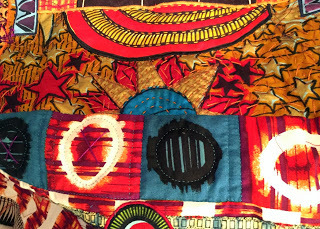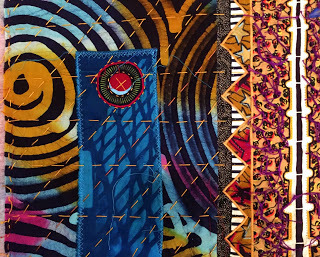A Way With Line: Quilting
 Turtle Spirit is quilted with standard quilting thread
Turtle Spirit is quilted with standard quilting threadas well as perle cotton and embroidery floss.
By Gayle Pritchard, 2015.Fiber artists are a rare breed in the fine art world. They are often asked why they work in fiber vs. painting on canvas. I have one answer to that question: the quilting line.
As an element of art, line and implied line play a crucial role as a building block of any composition. In an art quilt composition, unlike a painting (unless you are Robert Rauschen-berg), you have an additional layer of line to consider. The quilting line as stitch is functional; it literally holds the layers of the quilt sandwich together. As the layers are quilted, a shallow relief forms, creating slight contrast on the surface with line and shadow. As a compositional element, this shadowed relief adds a layer to the composition that is missing in painting and other flat media. Quilts are not quite sculptural, but they are not flat, either, and this is why I love to make them.

This second layer of line should be a planned part of a finished fiber composition. The quilt top can be finished and still be completely transformed by the manner in which line is applied in the form of quilting to finish the piece.
In Turtle Spirit, for example, you can see how the grid formed by the quilted line, executed here by hand with perle cotton and a darning needle, constrasts with the circular pattern of the underlying African fabric used for the side panels.
 Grids of lines run across grids and circles;
Grids of lines run across grids and circles;tufts of embroidery floss change the color and
texture of the underlying fabric
As in any artwork, the line created by quilting leads the viewer's eye around the composition, creating emphasis and contrast. Additionally, it can be used to flatten areas, causing them to recede visually while simultaneously drawing attention to the adjacent area. I have spent my career playing with these contrasts, and I love it still.
Published on November 10, 2015 06:46
No comments have been added yet.



